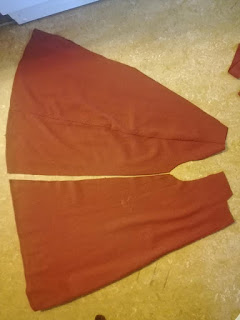Going to SCA Drachenwald 25 years anniversary and Midsommer Coronation in Bulgaria the upcoming week, I had loose plans on making a new dress. As most people does. But the silk I ordered from the US is still in customs, so no new dress for me. And it is not like I am at the risk of having to go naked, there are plenty of kirtles in this girls closet.
But I could always use some new headwear. Because I love headwear, it makes such a difference for an oufit and with plenty of headwear it is easy to alternate and it packs easy.
As a newbie Laurel, I do not have much insignia other than my medallions. And sometimes one simply has to bling up a bit. So I decided to make a laurel wreath, similar to one I made for my mistress, Joutsenjärven Sahra, using a brocade band with attached laurel leaves in gilted leather.
But I could not make a thing without finding some kind of period sources or inspiration for it. So I had a look through my art database and found a number of late 15th Century german depictions of wreaths used by women.
Some seem to be actual flower wreaths but other are to stylised to be simply a flower wreath. And the bride in red in the middle is wearing a small circlet with beads and a central flower of semiprecious stones or the like.
So with this supporting my idea of making a SCA-anachronistic wreath, I went on to sewing a band in dark red silk brocade and then cutting and attaching leaves of gilted leather to it. I decided to make it open in the back so I can pin it on different headdresses as well as just on top of my braids, as seen in the pictures.
I sewed the leaves onto the band with silk and left the front uncovered, but then it looked like it needed something. Back to the drawing board! I finally went with a little flower out of glass beads, similar to the one on the bride in her red dress. And in order for the gilted leather leaves not to look to bland, I added some beads inbetween them too, to look like litte berries and brighten things up.
So now I have a very blingy wreath that also travels easily and can be rolled up and put in a bag without any fear of breakage. And I am looking forward to wearing it!









































